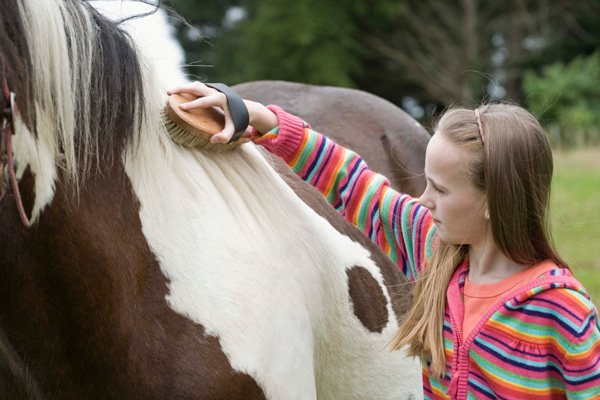
In light of the heightened wildfire and weather-related disasters we have already seen this year, we are sharing a three-part reference series from Colorado State University Extension about preparing for a disaster, what to do during a disaster, and how to care for livestock after a disaster.
Quick Facts….
- Livestock can sense some impending disasters before humans recognize a threat.
- Animals, and owners, can benefit from disaster drills.
- The proper disaster management approach varies with each type of event.
- Livestock management priorities differ before, during and after disasters occur.
- Disaster preparedness can lessen the impact for you and your livestock.
Many people in the United States are moving back to rural communities. For many reasons, these new rural residents often desire a lifestyle that includes owning horses, cattle, goats, ducks, chickens, sheep, llamas, alpacas and others. As people move closer to their natural resources, they also move farther away from the protection offered by urban and suburban infrastructure. It can be argued that rural living offers improved aesthetics, lower noise levels, and the feel of more “elbow room.” These characteristics come with the responsibility of handling a larger share of emergencies that are often encountered in rural areas.
In most cases, the response time and resources in rural areas are greatly reduced. Handling disasters, those catastrophic events that stretch the capacity of communities, can only be approached with preparedness, pre-planned reaction and post-event mitigation. During a disaster event, rural residents often find their personal safety a large enough challenge without the added burden of caring for livestock. This fact sheet discusses the basic realities of livestock management before disasters occur.
Before Disaster Strikes
In the Western United States, disasters typically occur from wildfire, flood, blizzard, tornado, hail storm or drought. First, determine if your livestock is in an area that is prone to a specific disaster type. For example, living near a flood plain increases the chance of flooding; and living in a wooded, mountainous region increases the chance of wildfire.
Next, learn which factors (e.g., climate) accelerate these risks into an actual disaster. There are links between risk and occurrence such as more wildfires during drought periods or large clashing hot and cold fronts generate tornadoes.
Disaster preparedness begins with awareness, but requires vigilance and planning.
In the 1930s, Kansas residents in tornado-prone areas built deep root cellars and kept a tornado box. In the box they stored copies of vital records, dry food, water, candy, blankets, cooking utensils, changes of clothing, medicines, candles or a lantern, and toys (if they had children). They also kept a list of what they wanted to grab in 10 minutes, or less, from the house such as photographs, heirlooms and clothing.
Since the safety of you and your family are the top priority, livestock care must come after you address human needs. However, preparing a disaster boxfor livestock still has great merit. Consider keeping this type of box in your vehicle or tack compartment of your trailer, if you have one.
Recommended items for a livestock disaster box include:
- Tack, ropes and halters
- Concentrated feed, hay, supplements and medicines
- Copies of ownership papers
- Buckets or feed nets
- Garden hose
- Flashlight or lantern
- Blankets or tarps
- Lights, portable radio and spare batteries
- Livestock first aid supplies
Additional Recommendations
Consider the following prior to floods, tornadoes, fires, blizzards and other natural disasters.
- Learn what disaster risks are prominent in your area and what conditions accelerate that occurrence.
- Contact local law enforcement and emergency response agencies and familiarize yourself with their response patterns, criteria and capability. Make sure you also contact the official in charge of disaster response. Give the local emergency manager a brief description of you, your operation and your equipment.
- Visit with neighbors or local groups about organizing a management or evacuation system for livestock.
- Evaluate your own handling capabilities including manpower, equipment and alternatives.
- Contact friends or family who are 15 to 40 miles away and make emergency arrangements with them for temporary livestock care.
- Identify facilities and resources that may be available 15 to 40 miles from your site. This works well with agriculture producers and stables for the same contingency.
- Make sure you have legal and adequate markings to prove ownership of your livestock. Refer to state and local laws for legal requirements. Consider having ID tags (such as luggage tags) on hand that you can attach to any animals that are halter broke. You might consider having livestock marker crayons or bright-colored paint convenient to mark your animals and your premises. For less domesticated livestock you may be dependent on brands, ear tags and ear notches. Have individual and group photographs of all livestock in your livestock disaster box.
- Practice loading your animals so you and the animals are familiar with the effort.
- Monitor television and local radio broadcasts regularly if risk factors are present.
- Identify an alley, lane or pen that can easily be used to confine animals and is readily adjacent to where a trailer or truck can access them.
- Utilize cell phone technology to monitor neighbors, families and livestock, but be aware that cell phones might not work during some disasters.
Authors
S. Cotton, Colorado State University Extension Pueblo County range management agent and Extension Disaster Education Network (EDEN) coordinator; T. McBride, Colorado State University Adams Count Extension director (emeritus), livestock agent, EDEN.


